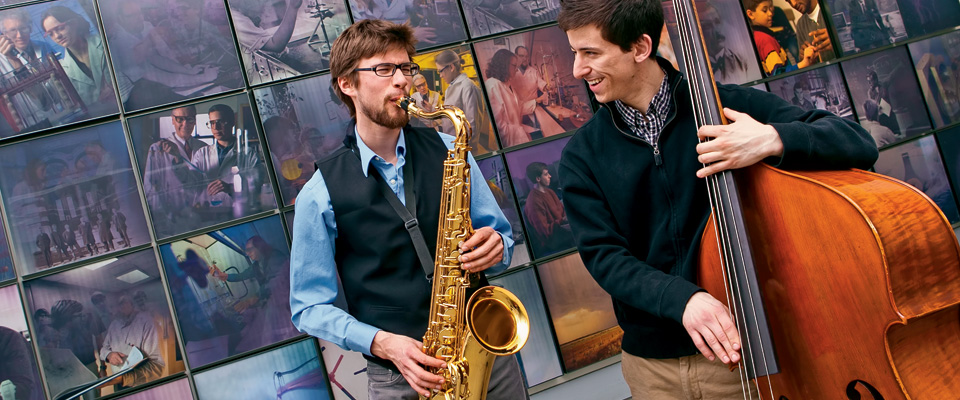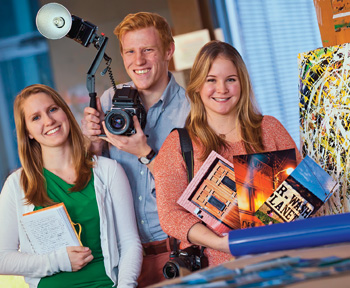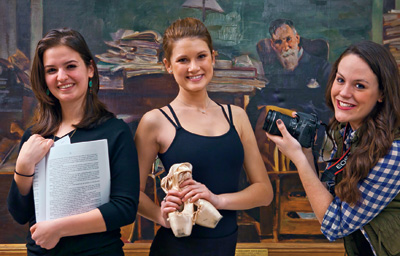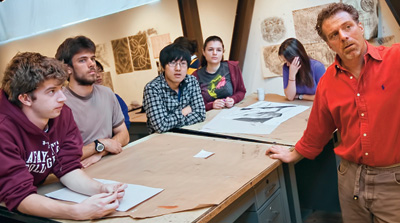Mar 20, 2014
New York
With open arms, you welcomed me To your streets, With your swanky charm. Evoking a sultry nocturnal quality But remaining aggravatingly unmoving On the…

Michael Pinkard ’14 (left) and John Paul Bisciotti ’14
by Geoff Gehman ’80 | photography by Chuck Zovko
Chalk for wall drawings. An amplifier for a bass. Rent for a science-writing job. A studio for teaching dance. Inspiration for making a film about a boy who yearns to learn to dance.
These are five examples of the way that 11 Lafayette seniors have used the benefits of the Creative and Performing Arts (CaPA) program, launched the year before they enrolled to allow students to pursue and develop their creative abilities. Over four years they’ve created creative communities through community outreach, field trips, and personal projects funded by individual stipends of up to $7,500. By linking their major passions to their majors, they’ve extended the College’s mission to use the arts to help students become communal scholars and global citizens.
CaPA is endowed by Bruce ’65 and Jackie P’02 Maggin. Bruce is principal with The H.A.M. Media Group, which advises and invests in entertainment and communications. The program is coordinated by Jim Toia, founding director of the Community-Based Teaching Program, where high schoolers and adults learn from faculty members, honors students, and guest artists. Toia helps the 32 CaPA fellows, including the 11 who are the first to benefit from the program through all four of their years at Lafayette, choose equipment, develop projects, and refine real-world skills such as collaboration and negotiation.

Elisabeth Burnor ’14 (L-R), Will Rockafellow ’14, and Elizabeth Anderson ’14
Students applying to the College for admission may apply at the same time for a CaPA Fellowship but through a separate process. CaPA has been a valuable recruiting tool. A healthy stipend helped convince John Paul Bisciotti ’14 that he could be a busy engineering student and a busy jazz bassist. As a first-year student he used CaPA money to buy strings, a bridge, and an amp that didn’t hiss and pop. A bettersounding, better instrument gave him the confidence to lead a band that opened for professional musicians during Lafayette’s fall festival.
Ann Lauer ’14 was “absolutely psyched” by the promise of CaPA money and camaraderie. A ballet dancer since age 3, she chose Lafayette even though the College doesn’t have a dance program. She created her own program by studying modern dance with Carrie Rohman, assistant professor of English and choreographerperformer, and by teaching ballet in a Kirby Sports Center studio that she secured with Toia’s aid.
“It was tough at first because there was little connection on campus to the dance world,” says Lauer, who is majoring in economics and English. “It’s easier now. I’m part of a little family.”
CaPA didn’t lure Joel Vargas ’14 to Lafayette. He discovered the program during his first year through Associate Professor Andy Smith, his mentor in film and media studies. It caused him to stay. He withdrew an application to New York University’s vaunted film school largely because Smith, Toia, and fellow fellows persuaded him he could be more productive in Easton.
Like Lauer, Vargas created his own creative tribe. He studied directing and cinematography in Prague, at the Film and Television School of the Academy of Performing Arts, funded by his Benjamin A. Gilman International Scholarship. He used CaPA funds to purchase a camera, lenses, and editing software. He is at work on a short film about a motherless boy who gives himself an unusual 14th-birthday gift: dance lessons from prostitutes.
“CaPA made me feel welcome and inspired,” says Vargas, who last year was selected as a reserve for a prestigious Marshall Scholarship, awarded annually to up to 40 students to study in the United Kingdom. “When I find myself in a creative or an academic slump, I meet with the fellows and find out the cool things they’re doing. And I think to myself: All right, Joel, you need to get your crap together and start producing stuff. It’s a nice pressure.”
CaPA has spurred community outreach for Samantha Ladell ’14, a psychology/art major involved in art therapy. She used part of her stipend to buy chalk and paint for area youngsters to create art on the “Young Masters Wall” she created along Easton’s new Karl Stirner Arts Trail. Fellowship funds also paid for props for teaching art to senior citizens with dementia, during a summer internship she served with the support of the new Preminger Gerontology Scholar Program, made possible by a gift from Marc ’71 and Lynne Preminger. According to Ladell, rubber ducks and a Tupperware pond helped a friendly, forgetful woman rekindle her love of the beach and her ability to follow instructions.

Madeline Gambino ’14 (L-R), Ann Lauer ’14, and Alyson Shumeyko ’14
“It turned out that she could model what you told her if you sat next to her and gave her one-on-one guidance,” says Ladell, who plans to become a private counselor. “It was a great feeling to know that she could draw if you helped her focus her attention.”
CaPA has triggered many chain reactions between arts and academics. Elizabeth Anderson ’14 discovered a passion for photography during a trip to Amsterdam, Berlin, and other photogenic European cities. The English/art major expanded this passion during a course on art and history that included studying in Russia and an economic-empowerment session in Honduras. These journeys will be illustrated in her English independent project of photos and poems. CaPA funds will pay for exhibit costs. Organizing and publicizing the show will help prepare her for a career in public relations or advertising.
Like Anderson, Elisabeth Burnor ’14 has mixed domestic and foreign projects. Her CaPA connection led the biology/English major to write for the Lafayette blog, which connected her to more students. Inspired by a semester in Costa Rica studying biology and Spanish, she accepted a writing internship last summer with the Academy of Natural Sciences in Philadelphia. Her nonprofit employer couldn’t pay her, so she used CaPA money for transportation and rent. Working for a big environmental institution and living in a big environment will help prepare her for a career in environmental community service.
A single remark during a CaPA event changed the writing direction of Madeline Gambino ’14, a prolific author of futuristic fiction. Last spring the religious studies/history major attended a dinner where a guest artist lamented that creativity can be “boxed in” by celebrity. The comment provoked Gambino to start her first novel in which art and music play major roles. In the process she changed her focus from a turbulent society to a stable society, her perspective from masculine to feminine. She also created her first female protagonist.
Gambino and Burnor are members of a CaPA collective. They review each other’s writings and techniques. Burnor admits that Gambino’s productivity gives her “a little kick in the pants” to be more productive. She gave herself a kick by winning the 2012 Jean Corrie Poetry Prize for her poem “On Earwigs.”

Jim Toia, director of community-based teaching, critiques students’ artwork in a drawing class at Williams Visual Arts Building.
Her CaPA fellowship has been Ann Lauer’s motivation. Empowered by the program’s enthusiastic writers and readers, she switched her second major from biology to English. Two years later, she’s a better writer “by far.” She loves reading, which she didn’t enjoy in high school. Last semester she took three writing courses, including one on poetry with Lee Upton, professor of English, writer-in-residence, and guide for several CaPA fellows.
“It’s a wonderful experience to witness emerging artists develop their gifts both independently and in collaboration,” says Upton, who accompanied Gambino to a writers conference and helped her pitch a book project to an agent. “We can be grateful for the CaPA fellows’ energy, generosity, and commitment.”
That energy, generosity, and commitment are becoming more well-known on campus.
In 2012 the CaPA Cabaret was created to promote the program, unite fellows, and showcase talents. For two years it’s been a lively revue of dance, song, poetry, and juggling. One of the featured acts is a jazz band led by bassist John Paul Bisciotti and tenor saxophonist/ composer Michael Pinkard ’14, who last semester studied mathematics and jazz in Budapest. Students have flocked to a smorgasbord of performers and foods. Biscotti calls the spread “the best $5 meal you’ll get all semester.”
For Alyson Shumeyko ’14, the 2013 cabaret was a coming-out party: She sang solo for the first time since recovering from sinus surgeries. A double major in English and film and media studies, she was coached by Aleni Mackarey ’16, CaPA fellow and fellow member of Lafayette Chamber Singers. Shumeyko says Mackarey calmed her before the show and boosted her spirits by secretly videotaping her performance.
Shumeyko, who feels that CaPA is still little known at Lafayette, plans to raise the profile by videotaping interviews with fellows. Posted on her blog, the profiles will serve as a portrait of the program’s “legacy.” They will double as a tribute to coordinator Toia’s affable, available leadership. His good deeds include helping art majors Ross Houston ’14 and Will Rockafellow ’14 buy cameras to document projects, curating Elizabeth Anderson’s photography during dinner in a Mexican restaurant, and introducing Shumeyko to a dynamic African rock guitarist called Bombino.
“Jim is like a goofy uncle who gives great advice,” says Shumeyko. Adds Gambino: “He’s undyingly there for us. He’s excited about what we’re excited about.”
Toia is excited about Bisciotti’s recent proposal that CaPA sophomores mentor first-year fellows, providing an important early source of peer guidance. He looks forward to helping fellows assist such Lafayette initiatives as the 3rd Street arts campus and an infusion of the arts in the curriculum funded by an $800,000 Mellon Foundation grant.
He expects to follow the postgraduate paths of Shumeyko, who plans to use CaPA money for singing lessons, and Lauer, who plans to use funds to study dance while working for a company headed by Donald Trump.
Toia will monitor the career of Vargas, his CaPA protégé. Vargas predicts his filmmaking will be shaped by Toia’s tips on visual storytelling, advice given while watching movies and visiting museums. Vargas views a trip to a Pennsylvania complex associated with the Wyeth family, where Virginia Logan ’81 is executive director, as a seminar on the relationship between painting and place.
Vargas was impressed by the two-story window in the studio of N.C. Wyeth, the larger-than-life illustrator and clan patriarch. “I want a workshop like that, if I can afford it,” he says. “I need that much light in my life.”
With open arms, you welcomed me To your streets, With your swanky charm. Evoking a sultry nocturnal quality But remaining aggravatingly unmoving On the…
Name Major Arts Interest Christine Calella ’16 English dance Julia Campbell ’15 English music/flute Ian Crawley ’15 Physics theater sound design…